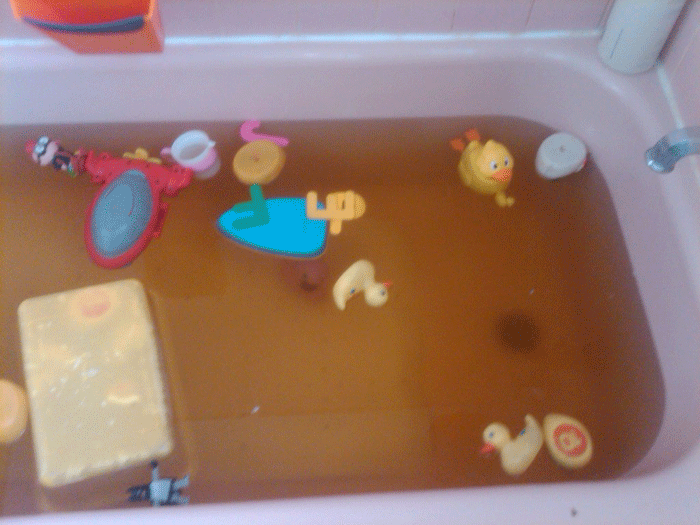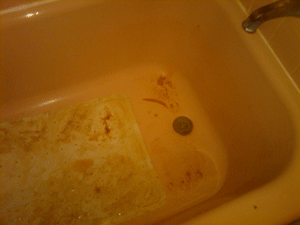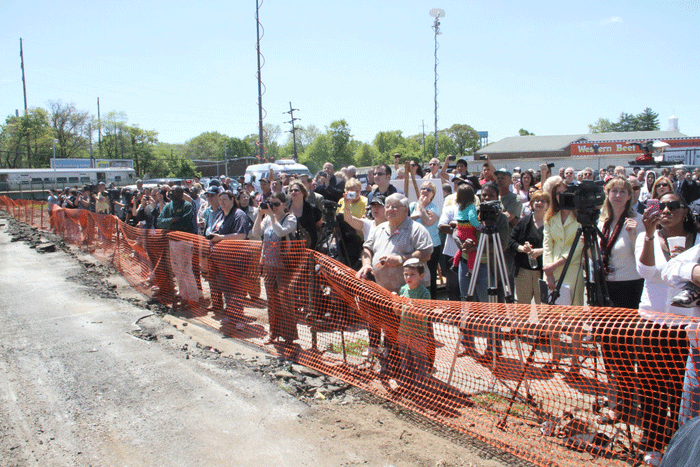
Copyright LIHerald.com
Malverne resident Dawn Wladyka drained her tub of the brown water she has become accustomed to, but this time found that it had left behind a mucky residue.
By Lee Landor
[Note: This article and its accompanying photos originally appeared on LIHerald.com on Feb. 9, 2011. This content is the rightful property of Richner Communications, Inc.]
Most people don’t think twice about running a bath or filling a glass with tap water: They simply turn on the faucet and, voilà, out comes clear, colorless water. On rare occasions, you might have to let the water run for a minute to clear out sediments or rust particles that accumulate in the pipes.
That is not the case in some areas of Malverne, where the water, no matter how long many residents let it run before putting the stopper in the tub or filling a glass, remains various shades of brown.
It has been that way as long as anyone can remember. For Dawn Wladyka, it has been six years. For Tom Grech, 10 years. But until recently, most residents believed their brown water was unique to them, to their homes, to their pipes. They didn’t realize it was a widespread problem until late last month, when Grech took to the Internet to gripe about it.
“On a lark, I put something on Facebook,” he recently told the Herald. In just four days, Grech’s Facebook group, “I Love Malverne but hate the brown water (from LI Water),” grew to include 130 members and hundreds of posts.
Grech is now trying to mobilize his fellow Malvernites in a stand against water supplier Long Island American Water, the company that he and other residents believe is to blame. At the very least, they want some answers.
“I’m not going to make it a federal case,” Grech said, “but I am definitely going to hold them accountable.”
While it has long been a nuisance, the problem appears to have worsened in recent months, according to Wladyka, a mother of three young children who enjoy taking baths. The water is more discolored than ever and now leaves a residue in the tub after it’s drained, she said, adding that this is where she draws the line.
“It used to be, ‘Oh, it’s just Malverne water.’ Kind of a complacency,” Wladyka said. “I felt like we were beaten down. You try to do everything you can … but you just deal with it.”
Until recently, that is, when Wladyka began to run a bath for her youngest, who, for the first time, made a face and refused to go in the brown water. “I reached a boiling point,” Wladyka said. She took photos of the water and posted them on Facebook. Shortly thereafter, Grech’s group was born.
Wladyka is certain that the problem is neither in her pipes nor with her water heater. Like many others who have shared their stories on Facebook, she has hired plumbers and others to determine whether something is wrong with her plumbing and has been told time and again that there is no problem.
Malverne resident and former Deputy Mayor Don Pupke said he firmly believes “the common problem is Long Island [American] Water.”
The company opened a new iron filtration plant on the Malverne-Lynbrook border in late October, promising to remove more iron from the water. Iron, according to LIAW President Bill Varley, is what turns the water brown. The recommended limit for iron is .3 milligrams per liter of water, according to the New York State Department of Health, and accompanying concerns include rust-colored staining of fixtures and clothes.
According to LIAW’s own water quality report, its water contains .75 milligrams per liter of iron, but “Higher levels of iron may be allowed by New York State when justified using treatment by the water supplier, as is the case with Long Island American Water.”
Additionally, Varley told the Herald last week, “Iron is not a health hazard — it’s strictly an aesthetic problem. Granted, it’s a nuisance. We know that, and we appreciate it.”
That is one reason the company opened the iron filtration facility. But the plant never came online. Varley explained that the paint in the plant’s new tanks has not yet cured completely, forcing the company to continuously flush the system, which is why residents are seeing more discolored water.
Then why, Pupke asked, has the company been telling residents to check their pipes and water heaters? Why, he wants to know, hasn’t LIAW informed its customers that the plant is not yet online?
“Shame on me for not coming to the mayor and saying, ‘Guess what. That plant we cut the ribbon on a couple months ago — it’s still not in service,’” Varley said at a Feb. 2 Board of Trustees meeting, which he attended to discuss the matter. He told trustees and residents that it could take anywhere from a week to two months to get the plant online.
Although Varley would not comment on why customer service representatives had suggested the problem might stem from pipes and water heaters, he told the Herald he regrets his failure to address the issue. “I should have proactively gone out and communicated,” he said. “It’s a shame — we just spent $7.5 million [to open the plant] and people think nothing’s changed.”
Grech, who called the company’s approach to the matter “disingenuous,” said that LIAW created more problems than it would have with some outreach. But he plans to continue to hold meetings, write petitions and obtain independent tests of water samples throughout the village.
“We’re going to band together as a community and tell Long Island American Water that it is unacceptable,” Grech said, adding that he expects to see the company step up, provide answers and take action. But, he added, “I don’t want promises — I want guarantees.”
The Malverne Civic Association is expected to hold a meeting to discuss the matter with Varley and other LIAW representatives on Feb. 10 at 7:30 p.m. in the basement of the Malverne Public Library, at 61 St. Thomas Place.


